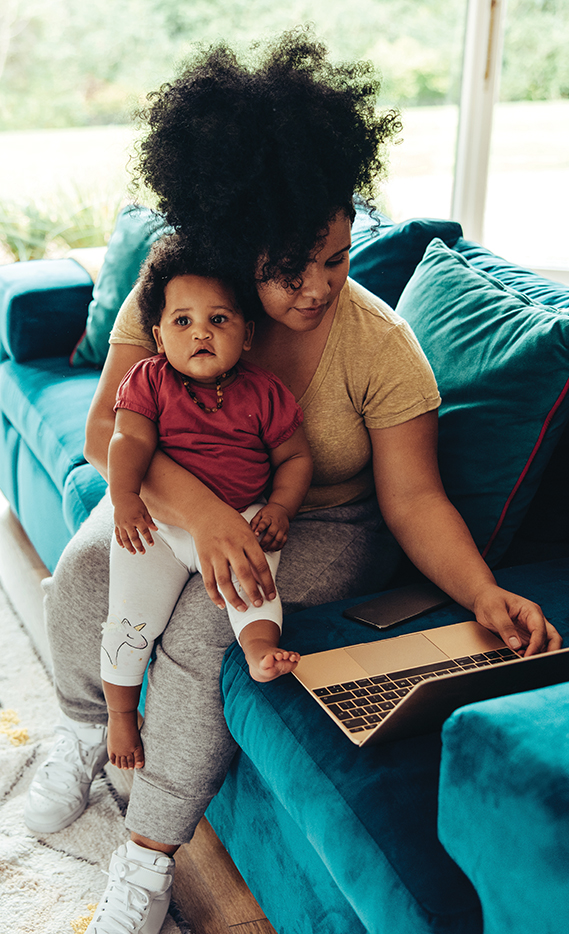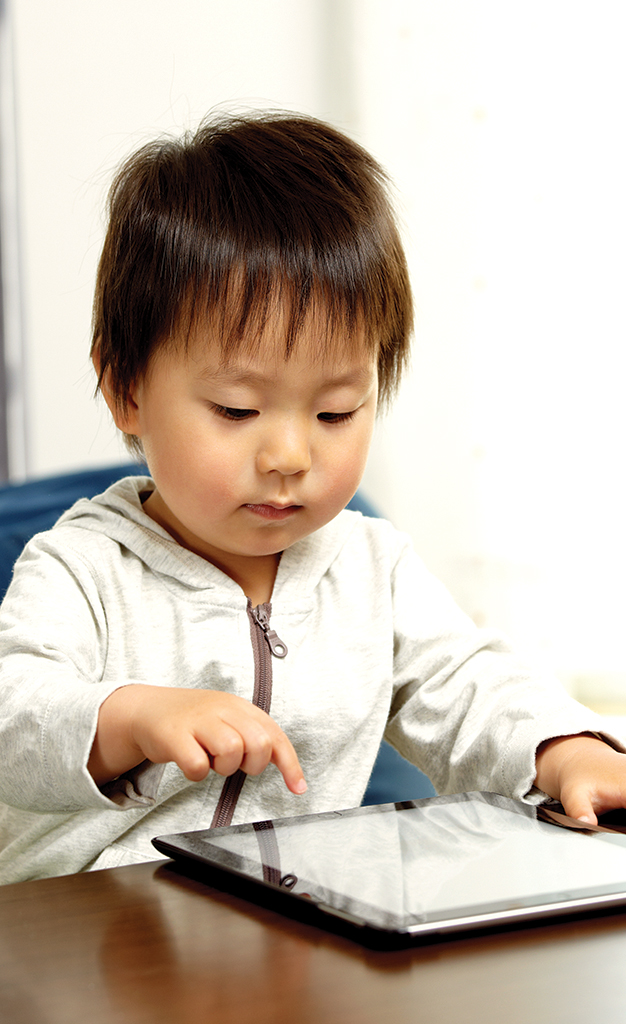
Professor Laura Justice
The Riveting Research in Early Childhood blog series is a succinct summary of a new study with compelling design and implications.
February 2022
By: Dr. Laura Justice
Research citation: Mallawaarachchi, S. R., Anglim, J., Hooley, M., & Horwod, S. (2022). Associations of smartphone and tablet use in early childhood with psychosocial, cognitive and sleep factors: a systematic review and meta-analysis. Early Childhood Research Quarterly, 60, 13-33.
A brief look at the study’s background
For some time, physicians and psychiatrists have encouraged caregivers with children ages five and under to carefully monitor and manage their children’s screen time. They recommend, for instance, that children under 18 months of age only use screens occasionally for video chats, and that for preschoolers, non-educational screen time be limited to one hour per day during the week.
While moderate screen time appears to offer some benefits to young children in development of fine motor, self-regulation, and early academic skills, a primary concern of screen time for young children is that it may displace other developmentally important activities, such as having conversations with adults, looking at books, and engaging in outdoor play. If unsupervised, screen time can also expose children to inappropriate content, such as sexual behavior, predators, and inaccurate information.
The importance of understanding the effects of screen time on children became particularly vital with the arrival of the iPhone in 2007 followed by the exponential explosion in children’s access to smart phones and tablets. Mallawaarachchi and colleagues (2022) note that such technologies are very appealing to young children as they are small in size, portable, and fit in a small child’s hand; for parents, smart phones and tablets also make solitary entertainment for the child possible.
As all readers know, the 2019-2022 pandemic changed everything regarding young children and screen time. Some young children participated in early learning programming virtually, such as the online summer camp offered by my colleagues and me during the summer of 2020 (Dore et al., 2021). Many early childhood programs were shuttered, and parents had to simultaneously care for their children while working from home. By virtue of these circumstances, screen time use by even very young children shot up dramatically, with one study (Dore et al., 2021) showing that kindergartners averaged 46 hours per week in screen time.

How the study was designed and what it found
Mallawaarachchi and colleagues’ study featured a meta-analysis as the primary research method. A meta-analysis is essentially a ‘study of studies,’ meaning that it is used to analyze findings across a variety of like-minded studies. In this case, the authors used a systematic approach to identify all studies that investigated the relationship between two main constructs: (1) children’s well-being in terms of cognitive, psychosocial, and sleep factors, and (2) children’s use of screen time (tablets and smart phones only), based on number of hours of use per week or in a given day. These studies would be correlational in nature, in that they focus specifically on describing the strength of the relationship between these two constructs. Correlation strength can be negative or positive based on a scale of -1.0 to +1.0 and is expressed as a correlation coefficient. A p value (which is a measurement of what portion of results could have happened by random chance) is then used to report whether the correlation is statistically significant at a .05 probability level (p). For instance, let’s say the correlation between height and weight is .70 (with a p value = .01). This signifies a large, positive, and significant correlation: basically, as height goes up, so does weight. Importantly, the magnitude of a given correlation coefficient must be framed within the context of what is being studied; in the social sciences, some correlations between constructs are fairly low (e.g., r = .20), but represent a meaningfully important relationship.
A benefit of this meta-analysis is that it averages the correlation strength across similarly designed studies, which is important because studies vary in their quality. By averaging correlations across studies, we remove the bias that would occur if we relied on the evidence from only one study.
In the present meta-analysis, the authors used a systematic search and screening procedure involving four databases of the archival research. In total, the authors identified 19 research articles that examined the correlations between children’s cognitive, psychosocial, and sleep factors and their screen time. These studies included 24 samples with a total sample size of 11,515 children; the average age of children across these studies ranged from 1.4 to 5.4 years.
First, the authors reported the average correlation between screen time and the aggregate child factors, finding a weak, negative, and statistically significant correlation of −.08 (p < .001). Second, the authors found a non-significant correlation of = −.07 (p = .115) for psychosocial factors and for cognitive factors (r = −.07, p = .14). Third, the authors found a small, negative, and statistically significant correlation of -.15 (p < .001) for sleep factors. Taken together, these findings indicate that increased use of screen time by young children is significantly but not strongly linked to overall childhood well-being, but largely via its impact on sleep quality, which may be due to the impact of blue ray emissions on sleep patterns. As the authors point out, blue ray emissions affect circadian rhythms, which in turn can lead to a variety of sleep disturbances (e.g., trouble falling asleep).

Why this study matters
Undoubtedly, screen time has increased in recent years due to the pandemic conditions, and it is important to understand how screen time may benefit or hinder the development of young children.
The studies included in this meta-analysis suggest that screen time most prominently affects young children’s sleep quality, an important finding given that poor sleep quality can lead directly to psychosocial and cognitive problems, such as attention issues or externalizing behaviors. It will be important for studies such as this to be replicated in the context of exacerbated screen time use during the global pandemic.
Importantly, correlational evidence pinpointing the relations between two constructs – in this case, children’s well-being and screen time – can lead to the development and evaluation of strategies designed to influence these constructs. For instance, given the negative relations between screen time and sleep quality in young children, scientists can test strategies to decrease screen time in the evening as a means to promote sleep quality, such as automated controls. In addition, public service announcements can be used to increase parents’ awareness of how screen time may detract from sleep quality and potentially other aspects of their children’s well-being.
References
American Academy of Child and Adolescent Psychiatry (2020). Screen Time and Children. Retrieved February 16, 2022 from https://www.aacap.org/AACAP/Families_and_Youth/Facts_for_Families/FFF-Guide/Children-And-Watching-TV-054.aspx.
Dore, R., Justice, L., Mills, A. K., Narui, M., & Welch, K. (2021). Virtual Kindergarten Readiness Programming for Preschool-Aged Children: Feasibility, Social Validity, and Preliminary Impacts. Early Education and Development, 32(6), 903-922.
Dore, R. A., Purtell, K. M., & Justice, L. M. (2021). Media use among kindergarteners from low-income households during the COVID-19 shutdown. Journal of Developmental & Behavioral Pediatrics, 42(8), 672-676.

Professor Laura Justice
Subscribe to the monthly Riveting Research blogs, and get an early look at some of the coolest new early childhood research.
By submitting this form, you are consenting to receive marketing emails from: . You can revoke your consent to receive emails at any time by using the SafeUnsubscribe® link, found at the bottom of every email. Emails are serviced by Constant Contact

